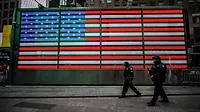Police officers & security guards account for 19% of workplace homicides

Image via Unsplash
Workplace violence accounted for nearly 18,000 worker deaths from 1992 to 2019, according to research from the Bureau of Justice Statistics (BJS) in the U.S. Department of Justice.
The Bureau of Labor Statistics (BLS) in the U.S. Department of Labor and the National Institute for Occupational Safety and Health (NIOSH) in the U.S. Department of Health and Human Services also contributed to the report.
The report, Indicators of Workplace Violence 2019, presents data for 13 indicators, including trends in workplace homicide, characteristics of workplace homicide, trends in nonfatal workplace violence, and more.
Workplace Homicide
A total of 17,865 workers were victims of workplace homicides from 1992 to 2019, according to the report. A total of 454 homicides took place in 2019. This marked a 58% decrease from a peak of 1,080 homicides recorded by the CFOI in 1994. This is compared to a 22% decrease in total homicides from 1994 to 2019.
During this period, all fatal occupational injuries also declined by 20%. From 2014 to 2019, workplace homicides increased by 11%. Workplace homicides have fallen more than 50% from a high of 1,080 in 1994.
Occupations of Workplace Homicide Victims
During 2015–19, 21% of victims of workplace homicides worked in sales and related occupations. Protective-service occupations, notably police officers and security guards, accounted for 19% of workplace homicides.
Persons in management occupations (e.g., owners or managers of restaurants and hotels) accounted for 9% of workplace homicides. Nearly 83% of workers killed during 2015–19 were in private industry. Workers in the public sector accounted for 17% of workplace homicides during that time.
Cause of Death in Workplace Homicide
During 2015–19, shootings made up 79% of workplace homicides (1,813). Stabbing, cutting, slashing, and piercing accounted for 9% of workplace homicides (199); hitting, kicking, and beating accounted for 7% (149); multiple violent acts accounted for 2% (34); and strangulation accounted for 1% (23).
Location of Workplace Homicide
Over 41% of workplace homicides occurred in a public building during 2015–19 (936). Private residences accounted for 12% of workplace homicides (278).
Workplace homicides also took place in industrial places/premises (178), streets or highways (353), and places for recreation or sport (28).
Rates of Nonfatal Workplace Violence, By Victim Occupation
During 2015–2019, workers in corrections occupations had the highest average annual rate of nonfatal workplace violence of the occupations examined (149.1 violent crimes per 1,000 workers age 16 or older).
Security guards (95.0 per 1,000) and law enforcement officers (82.9 per 1,000) had the next highest rates.
Rates of Nonfatal Workplace Violence among Government and Private-Sector Workers
During 2015–19, the average annual rate of nonfatal workplace violence against government workers (18.9 violent crimes per 1,000 workers age 16 or older) was more than three times that against private-sector workers (6.1 per 1,000).
Government law enforcement and security workers (74.7 per 1,000) had a higher rate of nonfatal workplace violence than other government workers, except for those in mental health occupations (77.1 per 1,000).
Among private-sector workers, those in law enforcement and security occupations had the highest rate of nonfatal workplace violence (70.9 per 1,000) of all occupation groups measured, including mental health occupations (31.4 per 1,000).
In the medical, mental health, and teaching occupations, government workers had higher rates of nonfatal workplace violence than workers in the private sector.
In the law enforcement and security, retail sales, and transportation occupations, there was no statistically significant difference in the rates of nonfatal workplace violence between government and private-sector workers.
The 9% of government workers in law enforcement and security occupations experienced 35% of the nonfatal workplace violence against all government workers.
Law enforcement and security workers made up 1% of all private-sector workers and experienced 7% of the nonfatal workplace violence against private-sector workers. Among government workers, retail sales comprised less than 1% of the workforce and experienced less than 1% of the nonfatal workplace violence.
Retail workers experienced 17% of the nonfatal workplace violence in the private sector, nearly double that of the private-sector workforce in that occupation group (9%).
Government workers in medical occupations experienced 18% of the nonfatal workplace violence against government workers and accounted for 8% of government workers. In the private sector, medical workers experienced 17% of the nonfatal workplace violence, representing 10% of the workers.
For the full report, visit www.bjs.ojp.gov.
Looking for a reprint of this article?
From high-res PDFs to custom plaques, order your copy today!





